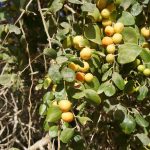 Also known as lotus tree, this deciduous shrub or small tree is a member of the buckthorn family, Rhamnaceae, and is native to the arid and semi arid areas of the Mediterranean area where it grows in woodlands, shrublands, and semi-steepes. The plant grow 5-16′ tall and has a deep taproot and smooth, zigzag, whitish branches bearing pairs of thin recurved thorns that are of unequal length and situated at the base of each leaf. The small leathery leaves have a thin cuticle and are ovate-oblong, nearly 2-ranked, and about 1/2″ long. In late spring to early summer, axillary clusters of small greenish flowers appear and give rise to a yellow, globose, pea-sized drupe that bears 2 seeds and is edible. Leaves, flowers, and stems are filled with mucilage. The plants respond well to coppicing and spread by root suckers and self-sowing, often forming dense unwanted thickets, and may be considered invasive. The density and thorniness of the branches combined with the rapid growth to maturity makes it a good choice for a hedge. In addition, the plants are valuable for erosion control, fuel, and as a component in medicines. Wild jujube is thought to be the lotus tree mentioned by Homer in the Odyssey. The genus name, Zizphus, is derived from the Persian name zizfum. The specific epithet, lotus, is from the Greek word lōtos, used to denote certain plants.
Also known as lotus tree, this deciduous shrub or small tree is a member of the buckthorn family, Rhamnaceae, and is native to the arid and semi arid areas of the Mediterranean area where it grows in woodlands, shrublands, and semi-steepes. The plant grow 5-16′ tall and has a deep taproot and smooth, zigzag, whitish branches bearing pairs of thin recurved thorns that are of unequal length and situated at the base of each leaf. The small leathery leaves have a thin cuticle and are ovate-oblong, nearly 2-ranked, and about 1/2″ long. In late spring to early summer, axillary clusters of small greenish flowers appear and give rise to a yellow, globose, pea-sized drupe that bears 2 seeds and is edible. Leaves, flowers, and stems are filled with mucilage. The plants respond well to coppicing and spread by root suckers and self-sowing, often forming dense unwanted thickets, and may be considered invasive. The density and thorniness of the branches combined with the rapid growth to maturity makes it a good choice for a hedge. In addition, the plants are valuable for erosion control, fuel, and as a component in medicines. Wild jujube is thought to be the lotus tree mentioned by Homer in the Odyssey. The genus name, Zizphus, is derived from the Persian name zizfum. The specific epithet, lotus, is from the Greek word lōtos, used to denote certain plants.
Type: Deciduous shrub or small tree
Outstanding Feature: Adaptability
Form: Rounded
Growth Rate: Rapid
Bloom: Axillary clusters of small greenish flowers in late spring to early summer
Size: 5-16′ H
Light: Full sun
Soil: Average to lean, medium moist to dry, well-drained; tolerates alkalinity and drought
Hardiness: Zones 11 and warmer
Care: Low maintenance
Pests and Diseases: None of significance
Propagation: Fresh stratified seed, division of suckers in dormant season, hardwood cuttings in winter
Outstanding Selections: Unavailable
Photo Credit: Wikipedia